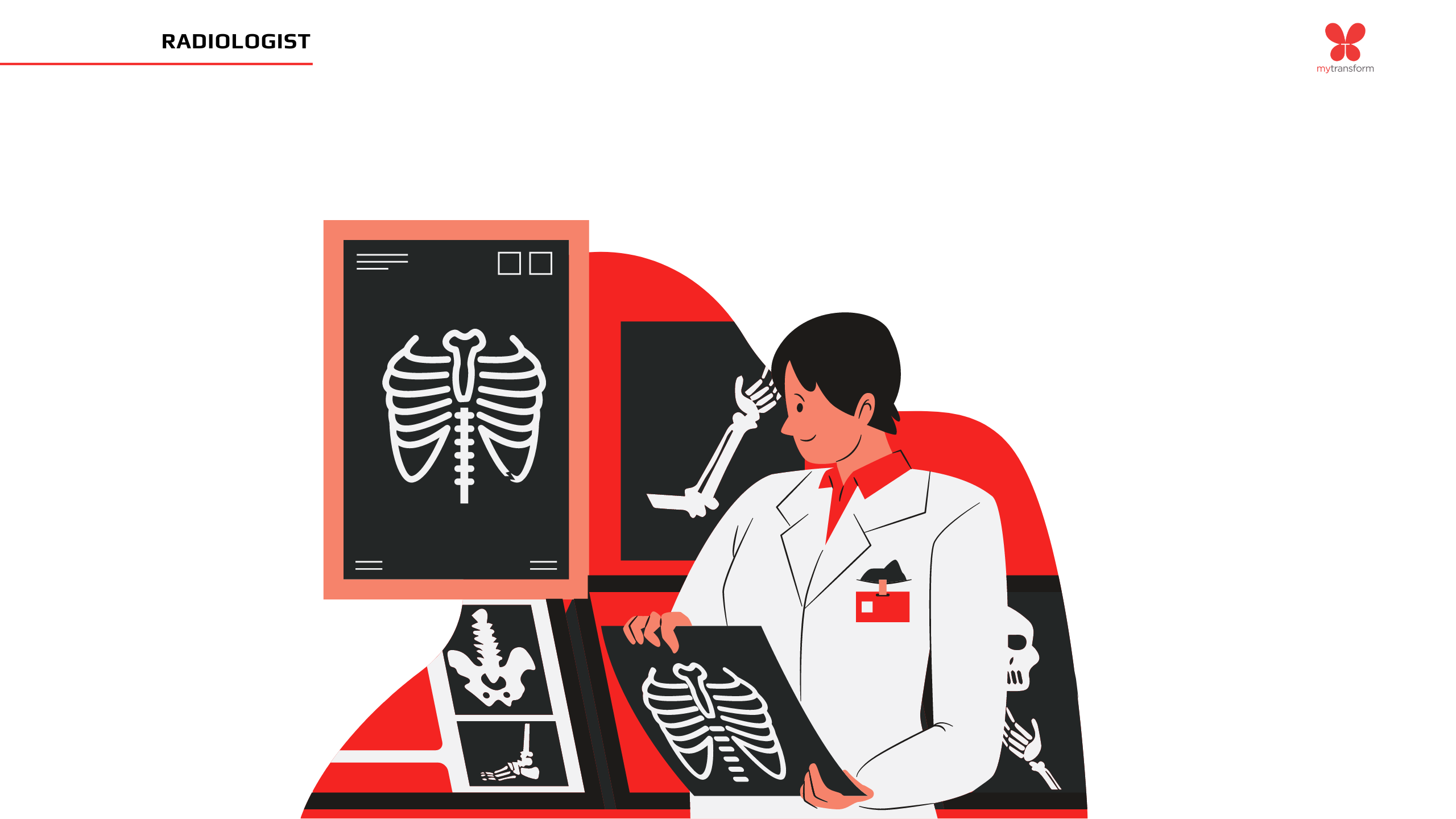
Radiology is a medical specialty that uses imaging techniques such as X-rays, MRI, and CT scans to diagnose and treat diseases. In India, radiology is a well-established and growing field, with a large number of trained radiologists, hospitals, and imaging centers.
If you are wondering ‘How to become a Radiologist in India?’, this article will provide all the details on radiologist work, radiologist course duration, radiologist salary in India, etc.
Who Is A Radiologist?
A radiologist is a medical doctor who specializes in diagnosing and treating illnesses and injuries using medical imaging techniques such as X-rays, computed tomography (CT) scans, magnetic resonance imaging (MRI) scans, and ultrasound.
They typically work in hospitals and clinics, interpreting images and providing diagnostic information to other healthcare professionals. They may also perform interventional procedures, such as biopsies, using imaging guidance.
Types Of Radiologist In India
In India, there are several types of radiologists that specialize in different areas of radiology. Some of the common types of radiologists include:
1. Diagnostic Radiologists:
These radiologists specialize in interpreting medical images such as X-rays, MRIs, and CT scans to diagnose and treat medical conditions.
2. Interventional Radiologists:
These radiologists use imaging technology to guide minimally invasive procedures such as biopsies, angiograms, and other interventional procedures.
3. Neuro-radiologists:
These radiologists specialize in interpreting images of the brain, spine, and nervous system to diagnose and treat conditions such as tumors, stroke, and degenerative diseases.
4. Musculoskeletal Radiologists:
These radiologists specialize in interpreting images of the bones, joints, and muscles to diagnose and treat conditions such as arthritis, osteoporosis, and sports injuries.
5. Pediatric Radiologists:
These radiologists specialize in interpreting images of children to diagnose and treat conditions such as congenital defects, growth disorders, and injuries.
6. Breast Radiologists:
These radiologists specialize in interpreting images of the breast to diagnose and treat conditions such as breast cancer and other breast-related conditions.
7. Nuclear Radiologists:
These radiologists specialize in using radioactive materials to diagnose and treat conditions such as cancer, thyroid disorders, and heart disease.
8. Radiology Oncologists:
These radiologists specialize in the use of radiation therapy to treat cancer.
It’s important to note that the above list is not exhaustive and there are many other subspecialties in radiology. Additionally, radiologists may also choose to specialize in specific areas of radiology such as body imaging, genitourinary radiology, and more.
What Does A Radiologist Do?
The main role of a radiologist is to interpret medical images and provide diagnostic information that is used to make treatment decisions. Some specific responsibilities of a radiologist include:
-
- Interpreting Medical Images: Radiologists review and interpret medical images such as X-rays, MRIs, CT scans, ultrasound, and other imaging modalities to identify any abnormalities or injuries.
- Communicating with Other Healthcare Professionals: Radiologists work closely with other healthcare professionals such as referring physicians, surgeons and radiologic technologists to ensure that patients receive the best possible care.
- Providing Diagnostic Information: Radiologists provide critical diagnostic information to other physicians and healthcare professionals, which is used to make treatment decisions.
- Performing Procedures: Some radiologists may also perform procedures such as biopsies, angiograms, and other interventional procedures.
- Keeping Up to Date with New Technology and Techniques: Radiologists are responsible for keeping up to date with new technology and techniques in the field of radiology and incorporating them into their practice as appropriate.
- Keeping accurate patient records and documenting their findings.
- Consulting with patients and other physicians in order to recommend a course of treatment.
- Participating in continuing education and professional development opportunities to stay current on new technologies and advances in the field of radiology.
- Participating in the quality control and quality assurance process of the imaging facility to ensure the best imaging results.
- Managing and supervising the Radiologic technologist in the imaging facility.
Radiologist Qualifications
To become a radiologist in India, the following qualifications are required:
-
- A four-and-a-half-year undergraduate degree (MBBS) from an accredited medical college.
- A three-year postgraduate degree (MD/DNB) in radiology from an accredited medical college.
- Registration with the Medical Council of India (MCI) as a qualified radiologist.
- Some radiologists may also choose to pursue additional training and certification in specialized areas such as interventional radiology, pediatric radiology, neuroradiology, and more.
It’s important to note that the qualifications may be subject to change based on the latest policies of the Medical Council of India (MCI) and institutions. Also, it’s important to note that becoming a radiologist is a challenging process and requires a significant investment of time and effort.
Skills Required to Become A Radiologist
Here are some key skills required to become a radiologist:
-
- Strong Analytical and Problem-solving Skills
- Technical Expertise
- Attention to Detail
- Good Communication Skills
- Strong Work Ethic
- Aptitude for Science and Technology
- Good Teamwork
- Continuous Learning
- Strong Ethical Principles
- Emotional Stability
How To Become A Radiologist In India? A Step-by-Step Guide
Here is a step-by-step guide on how to become a radiologist in India:
-
- Complete your 10+2 education with Physics, Chemistry, and Biology as main subjects.
- Clear the NEET (National Eligibility cum Entrance Test) to get admission to a Medical college for the MBBS (Bachelor of Medicine and Bachelor of Surgery) course.
- Complete your 4.5-year MBBS course and pass the final year examination.
- Appear for the postgraduate entrance examination like the All India Postgraduate Medical Entrance Examination (AIPGMEE) or any state-level postgraduate medical entrance examination for MD/DNB in Radiology.
- Complete your 3-year MD/DNB in Radiology course and pass the final year examination.
- After completing the MD/DNB in Radiology, you will have to work as a junior resident for 1 year.
- After completing 1-year Junior Residency, you will be eligible for registration with the Medical Council of India (MCI)
- After registration with the Medical Council of India (MCI), you will be eligible to practice as a radiologist.
Please note that the above information may be subject to change based on the latest policies of the Medical Council of India (MCI) and institutions.
Also, it’s important to note that becoming a radiologist is a challenging process and requires a significant investment of time and effort.
Career Opportunities For a Radiologist
There are many career opportunities for radiologists in India, including:
-
- Hospitals: Radiologists can work in government or private hospitals, both in urban and rural areas.
- Diagnostic centers: Radiologists can work in diagnostic centers, both independently or as part of a larger group.
- Research: Radiologists can work in research centers and universities, studying new techniques and technologies in the field of radiology.
- Teaching: Radiologists can work as professors or lecturers in medical colleges, teaching the next generation of radiologists.
- Teleradiology: Radiologists can work remotely and provide diagnostic services to patients in other locations through teleradiology.
- Online consultation: Radiologists can provide online consultation services to patients and other physicians
- Private Practice: Radiologists can also open their own private practice, either independently or as part of a larger group.
It’s important to note that the career opportunities can vary depending on the radiologist’s qualifications and experience.
Also, there are many opportunities for radiologists to specialize in certain areas such as interventional radiology, pediatric radiology, neuroradiology, and more, which allows for more career options and opportunities for advancement.
Radiologist Course Details & Duration
In India, the main courses for becoming a radiologist are:
-
- MBBS (Bachelor of Medicine and Bachelor of Surgery) – 4.5 years
- MD (Doctor of Medicine) or DNB (Diplomate of National Board) in Radiology – 3 years
- Post Doctoral Fellowship (PDF) in Radiology-1 to 2 years (after MD/DNB)
- DMRD (Diploma in Medical Radiodiagnosis) – 2 years
Please note that the duration of the course may vary depending on the institution, and the above information may be subject to change based on the latest policies of the Medical Council of India (MCI).
It’s important to note that MBBS is the basic requirement to become a radiologist, after that, one can pursue MD/DNB in radiology or DMRD.
PDF is an additional course that can be pursued after completing an MD/DNB in radiology to specialize in a certain area of radiology.
Top Medical Schools For Radiologists
There are many medical schools in India that offer radiology as a specialization, but here are a few of the top institutions considered to have strong programs in radiology:
-
- All India Institute of Medical Sciences (AIIMS), New Delhi
- Postgraduate Institute of Medical Education and Research (PGIMER), Chandigarh
- Christian Medical College (CMC), Vellore
- Tata Memorial Hospital, Mumbai
- Sanjay Gandhi Postgraduate Institute of Medical Sciences (SGPGIMS), Lucknow
Please note that this is not an exhaustive list and there are many other medical schools in India that also offer strong programs in radiology.
Salary Of A Radiologist In India
The salary of a radiologist in India can vary widely depending on factors such as location, years of experience, and the type of facility they are working in.
A fresh radiologist can earn an average of INR 6-8 Lakh per annum, while a senior radiologist can earn an average of INR 12-20 Lakh per annum.
It’s important to note that the salary range can be different based on the employer and location.
Some private hospitals and clinics may offer higher salaries than government hospitals or smaller clinics. Also, in metro cities the salary range can be higher than the non-metro cities.
Pros and Cons of Being A Radiologist
Pros of Becoming A Radiologist
Some pros of becoming a radiologist include:
-
- Good Job Prospects: Radiologists are in high demand and the field is expected to continue to grow.
- High Earning Potential: Radiologists typically have high earning potential and are well compensated for their skills and expertise.
- Ability to Use Technology: Radiologists use cutting-edge technology to diagnose and treat medical conditions, which can be challenging and rewarding.
- Variety of Specializations: Radiologists can specialize in different areas such as interventional radiology, pediatric radiology, neuroradiology, and more, which allows for more career options and opportunities for advancement.
- Helping People: Radiologists play a critical role in the diagnosis and treatment of patients, which can be very rewarding and fulfilling.
Cons of Becoming A Radiologist
Some cons of becoming a radiologist include:
-
- Long Education and Training Period: Becoming a radiologist requires a significant investment of time and effort.
- Stressful Work: interpreting medical images and making accurate diagnoses and treatment recommendations can be stressful, particularly when lives are on the line.
- Sitting for Long Hours: radiologists often spend long hours sitting in front of computer screens, which can lead to physical strain and repetitive stress injuries.
- High Responsibility: radiologists are responsible for interpreting medical images and providing critical diagnostic information, which can be a heavy responsibility.
- Limited Interaction with Patients: Radiologists often work behind the scenes and have limited interaction with patients, which can be less fulfilling for some.
Summary
-
- A radiologist is a medical doctor who specializes in using medical imaging techniques such as X-rays, CT scans, MRI scans, and ultrasound to diagnose and treat illnesses and injuries. They work in hospitals and clinics, interpreting images and providing diagnostic information to other healthcare professionals.
-
- In India, there are several types of radiologists that specialize in different areas of radiology, including diagnostic, interventional, neuroradiology, musculoskeletal, pediatric, breast, nuclear and radiation oncology, among others.
-
- Radiologists interpret medical images and provide diagnostic information for treatment decisions, communicate with other healthcare professionals, perform procedures, stay current with new technology, and manage and supervise radiologic technologists in imaging facilities.
-
- Key skills required to become a radiologist include strong analytical and problem-solving skills, technical expertise, attention to detail, good communication skills, strong work ethic, aptitude for science and technology, good teamwork, continuous learning, strong ethical principles, and emotional stability.
-
- To become a radiologist in India, one must complete a 10+2 education, clear the NEET, complete an MBBS and MD/DNB in Radiology, work as a junior resident for 1 year, and register with the Medical Council of India to practice as a radiologist.
-
- Radiologists in India can work in hospitals, diagnostic centers, research centers, teaching institutions, teleradiology, online consultation, or private practice. Specializing in certain areas can also open up more career opportunities.
-
- In India, the main courses to become a radiologist are MBBS (4.5 years), MD/DNB in Radiology (3 years), Post-Doctoral Fellowship in Radiology (1-2 years), and DMRD (2 years). MBBS is the basic requirement, with the option to specialize with additional courses.
-
- Top medical schools in India for radiology include AIIMS, PGIMER, CMC, Tata Memorial Hospital, and SGPGIMS.
-
- The salary of a radiologist in India varies widely and can range from INR 6-20 Lakh per annum, depending on factors such as location, experience, and type of facility.
-
- Pros of becoming a radiologist include high earning potential, good job prospects, use of technology, variety of specializations and helping people. Cons include long education and training, stressful work, sitting for long hours, high responsibility and limited interaction with patients.
Frequently Asked Questions
Radiology can be a good career choice for those interested in using technology to diagnose and treat medical conditions. It offers good job prospects, high earning potential and can be a challenging and rewarding field.
It takes around 7-8 years to become a Radiologist in India, following a four-and-a-half-year undergraduate degree (MBBS) and a three-year postgraduate degree (MD/DNB) in radiology, and a period of supervised training.
Becoming a radiologist in India is a challenging process, as it requires completing a rigorous medical education, including a four-and-a-half-year undergraduate degree (MBBS) and a three-year postgraduate degree (MD/DNB) in radiology, followed by a period of supervised training.
Being a radiologist can be a stressful job as they have to interpret medical images and make accurate diagnosis and treatment recommendations, which can have serious consequences if mistakes are made.
Yes, a radiologist is a doctor who specializes in using imaging technology such as X-rays, MRIs, and CT scans to diagnose and treat medical conditions.
AI has the potential to assist radiologists in their work, but it is unlikely to completely replace them in the near future. Radiologists play an important role in interpreting medical images and providing critical diagnostic information.
In India, a Surgeon generally earns more than a Radiologist, due to the fact that the surgical profession is considered more specialized and demanding, and typically requires a longer period of training.
A background in math is not strictly required, but analytical and critical thinking skills are essential for a radiologist.
Yes, anyone, regardless of gender, can become a radiologist if they have the proper education and training.
Yes, radiologists are in high demand due to the increasing use of imaging technology in healthcare. Learn more on how to become a radiologist in India in this article above.




